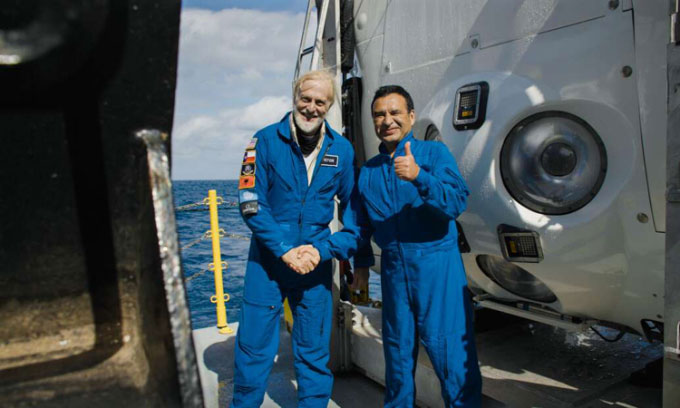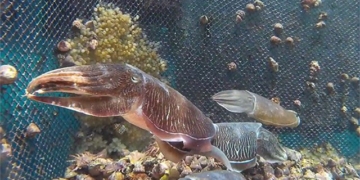Submarine withstands extreme pressure to take two experts to explore the deepest trench in the Eastern Pacific and observe a variety of marine life.
For the first time in history, a manned submersible has reached the bottom of the Atacama Trench, the deepest area in the Eastern Pacific. On January 21, ocean explorer Victor Vescovo and marine biologist Osvaldo Ulloa reached the deepest point of the trench known as Richards Deep, at a depth of 8,069 meters below sea level. They used the Limiting Factor submersible, which is designed to withstand extreme pressure.

Victor Vescovo (left) shakes hands with Osvaldo Ulloa (right). (Photo: Nick Verola/Caladan Oceanic)
The Atacama Trench, also known as the Peru-Chile Trench, was formed as the Nazca tectonic plate slides beneath the South American continental plate. This trench stretches 5,900 kilometers along a vast area off the western coast of South America.
The expedition to the bottom of the Atacama Trench was not just aimed at setting a record but also had significant scientific objectives. This is why Dr. Ulloa, director of the Millennium Institute of Oceanography (IMO), participated in the mission. The IMO is studying the bottom and depths of the Atacama Trench to install sensors for the future IDOOS project.
“It was a great honor to undertake the first manned dive to the bottom of the Atacama Trench with Dr. Ulloa. Gliding beneath the ocean for three hours and directly observing fascinating features with someone who has studied this area for many years was incredible,” Vescovo, founder of Caladan Oceanic, shared.
“This is a wonderful day for Chilean science. Thanks to Victor Vescovo and Caladan Oceanic, we are able to witness firsthand the geological and biological richness of the Atacama Trench. Exploring with Victor is a tremendous privilege and a rewarding experience. We are very grateful to him and the entire team of the Limiting Factor submersible and the support vessel Pressure Drop,” Dr. Ulloa said.
According to plans, the exploration of Richards Deep is the first mission among several dives in the Eastern Pacific, extending to the Central American Trench off the western coast of Mexico. During the recent dive, the expedition also explored the second deepest point of the Atacama Trench – 7,727 meters below sea level – located 142 kilometers north of Richards Deep. Vescovo and Dr. Ruben Escripano later visited this site on January 23.
At the astonishing depths of the Atacama Trench, the explorers encountered a plethora of thriving species. Footage they captured shows numerous sea cucumbers on the ocean floor, an area that had never seen sunlight before the submersible’s visit.
“Together, we observed some incredible evidence of what appear to be examples of chemosynthesis in the deep ocean trench. Here, we saw long bacterial structures extending from the surfaces of rocks that had never received sunlight, extracting energy from minerals and gases seeping from the rocks, surrounded by the frigid seawater. It was extraordinary,” Vescovo remarked.


















































